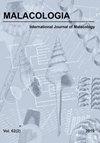Isaac Lea's (1792–1886) Substitutions and Other Modifications of His Own Names of Molluscan Species
IF 1
4区 生物学
Q4 ZOOLOGY
引用次数: 2
Abstract
ABSTRACT The American conchologist Isaac Lea had a long and productive career during which he introduced more than 1,800 names of molluscan species between 1827 and 1874, the majority North American land and freshwater species. His idiosyncratic way of publishing, by describing new taxa multiple times in duplicated and variously modified journal papers as well as in retitled collections of extracts, has led to considerable difficulties in determining accurate dates of his original descriptions. He considered the reading and presentation of a manuscript before a “learned society” as the date of its original publication and therefore his own recorded dates must be approached with caution. The problem of interpreting Lea's names was compounded by the fact that Lea frequently modified his own new taxonomic names in his subsequent publications, and often without providing justification for the change. The various name versions were inconsistently applied by subsequent authors. The current paper analyses Lea's substitutions and other modifications of his own names of molluscan species and discusses 131 of his publications in this context, for which attempts at precise dating were made. The status of these “replacements” of Lea's taxonomic names were evaluated under the current ICZN Code (1999). A few additional cases of changes of Lea's names by other authors are included; these are instances in which Lea had missed a primary homonym or a secondary homonym was discovered later. While some of the names here discussed are currently resting in synonymy, others are of greater current relevance as they are in use as valid names for taxa of conservation/management concern, including IUCN and U.S.-federally listed species. The following 98 discussions of often-complex name changes involve 348 species-group names and their subsequent spellings, 231 of which were introduced by Lea. Based on their current taxonomic status, the names belong to 4 bivalve and 11 gastropod families, with the vast majority concentrated in Unionidae and Pleuroceridae. Under the current ICZN Code, the investigated changes fall into many different categories, which impacts their nomenclatural availability: 35 names changed by Lea (plus 6 by other authors) are interpreted as substitute names for junior primary homonyms, 7 of which were unnecessary; 1 name (plus 6 by others) as substitute names for junior secondary homonyms, 1 of which was unnecessary; 13 names as justified emendations; 10 names (plus 1 by another) as unjustified emendations that have not entered prevailing usage; 1 name determined by his first reviser action; 37 names (plus many by others) as incorrect subsequent spellings that are not in prevailing usage; and 1 incorrect subsequent spelling that is shown to be in prevailing usage and thus considered a correct original spelling. The concept of “prevailing usage,” ill-defined under the current (1999) ICZN Code, is addressed in this context. The following names in current use are corrected as follows: Helix balasteriana I. Lea, 1840 (taxon inquirendum, ?Dyakiidae), Lioplax cyclostomatiformis (I. Lea, 1844), Diplodon demararaensis (I. Lea, 1859), Iheringella isocardiodes I. Lea, 1856, Dilatata brongniartiana (I. Lea, 1843), Elliptio nasutidus (I. Lea, 1863), Elliptio pullata (I. Lea, 1857), Pleurocera picta (I. Lea, 1841) [instead of P. curta (Haldeman, 1841), which is preoccupied] and Beringiana youconensis (I. Lea, 1847); many others are confirmed in their recently applied spellings. This work serves as an example that the basic endeavor of summarizing available and valid names from the published literature is not always a straightforward task.艾萨克·李(1792-1886)对他自己命名的软体动物物种的替换和其他修改
美国贝壳学家艾萨克·利亚有着漫长而多产的职业生涯,在1827年至1874年期间,他介绍了1800多个软体动物物种的名称,其中大多数是北美陆地和淡水物种。他独特的出版方式,通过在重复的和各种修改的期刊论文中以及在重新命名的摘录中多次描述新分类群,导致在确定他原始描述的准确日期方面存在相当大的困难。他认为,在“学术团体”面前阅读和展示手稿的时间,就是手稿最初出版的日期,因此他自己记录的日期必须谨慎处理。Lea经常在他后来的出版物中修改他自己的新分类学名称,而且经常没有提供修改的理由,这使得解释Lea名字的问题更加复杂。不同的名称版本被后来的作者不一致地应用。目前的论文分析了Lea对他自己的软体动物物种名称的替换和其他修改,并讨论了他在此背景下发表的131篇文章,试图对这些文章进行精确的年代测定。根据现行的ICZN法典(1999年)评估了这些Lea分类名称的“替代”地位。还包括其他作者更改Lea名字的其他几个例子;在这些例子中,Lea漏掉了一个主谐音,或者后来发现了一个次谐音。虽然这里讨论的一些名称目前处于同义词状态,但其他名称具有更大的相关性,因为它们被用作保护/管理关注的分类群的有效名称,包括IUCN和美国联邦政府列出的物种。下面98篇关于复杂名称变化的讨论涉及348个物种群名称及其随后的拼写,其中231个是Lea介绍的。根据它们目前的分类地位,它们的名字归属于4个双壳类科和11个腹足类科,其中绝大多数集中在联科和胸椎科。根据现行的ICZN法典,所调查的更改分为许多不同的类别,这影响了其命名的可用性:Lea更改的35个名称(加上其他作者更改的6个)被解释为初级初级同音异义名称的替代名称,其中7个是不必要的;1个名字(加上别人的6个名字)作为初中同音名的替代名称,其中1个是不必要的;经合理修订的13个名称;10个名称(加上另一个名称)作为不合理的修订,尚未进入普遍使用;名字由他的第一次修改动作决定;37个名字(加上其他人的许多名字)是不正确的拼写,不被普遍使用;1个错误的后续拼写,被证明是普遍使用的,因此被认为是正确的原始拼写。在现行(1999年)ICZN准则下定义不明确的“普遍用法”概念在此背景下得到解决。目前使用的下列名称已纠正如下:长尾螺(Helix balasteriana I. Lea, 1840)(类群inquirendum, Dyakiidae)、环口螺(Lioplax cyclostomatiformis, 1844)、demarplodon (Diplodon, 1859)、异心螺(Iheringella isocaroides, 1856)、长尾螺(Dilatata brongniartiana, 1843)、鼻尖螺(Elliptio nasutius, 1863)、白斑蝶(Elliptio pullata, 1857)、picurocera (I. Lea, 1841)[代替P. curta (Haldeman, 1841),这是重点]和白鲸(Beringiana youconensis, 1847);其他许多人在他们最近应用的拼写中得到了证实。这项工作作为一个例子,从已发表的文献中总结可用和有效的名称的基本努力并不总是一项直截了当的任务。
本文章由计算机程序翻译,如有差异,请以英文原文为准。
求助全文
约1分钟内获得全文
求助全文
来源期刊

Malacologia
生物-动物学
CiteScore
2.00
自引率
0.00%
发文量
15
审稿时长
3 months
期刊介绍:
Malacologia publishes papers on all groups of the Mollusca. Malacologia specializes in publishing long papers and monographic treatments. Complete data are especially appreciated. Papers must be of interest to an international readership. Papers in systematics, ecology, population ecology, genetics, molecular genetics, evolution and phylogenetic treatments are especially welcomed. Also welcomed are letters to the editor involving papers published or issues of import to science of the day.
 求助内容:
求助内容: 应助结果提醒方式:
应助结果提醒方式:


